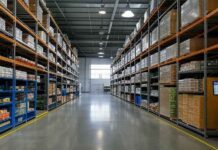At a time when global supply chains are becoming ever more complex and uncertain, the demand for stability and efficiency is higher than ever. Organizations are always working hard to manage issues like changing consumer preferences, geopolitical risks, and unexpected disruptions from natural disasters. In this competitive landscape, predictive analytics stands out as a key technology, helping businesses to turn weaknesses into strengths and opportunities for growth. The term predictive analytics supply chain is not just a buzz word — it is the next frontier of operational excellence combining bleeding-edge data science to real world logistics.
Supply chain predictive analytics using historical data, machine learning algorithms, and statistical models to predict future trends and events. This technology assists organizations in making proactive decisions through examining trends and isolating imminent risks, helping in organizations’ continuity, efficiency, and resilience. No wonder the impact of this predictive analytics is well and real, especially with given so much uncertainty in the markets today.
The Importance of Predictive Analytics in Supply Chain Resilience
Supply chains are the lifeblood of the global economy, but they are also vulnerable. The COVID-19 pandemic revealed how fragile even the strongest supply chains are and underscored the importance of increased agility and foresight. Predictive analytics solves these problems with actionable insights that enable companies to spot disruptions before they happen.
Predictive models, for example, can be used to review weather trends to predict possible transportation delays. And they can extrapolate supplier performance based on past data, helping companies spot alternative suppliers in advance. Recent market research suggests that businesses using predictive analytics in their supply chains have seen operational costs decrease by 30% while improving delivery times by 40%. Such numbers reflect the transformative power of this technology, and it is a necessity for any business looking to survive in a crowded field.
So, the predictive analytics supply chain is not merely built to eliminate risk; it is constructed to capitalize on opportunity. Companies can identify emerging trends and preferences among consumers, adjusting their strategies accordingly to capture new market segments. We saw leading retailers using predictive analytics during the pandemic to predict changes in shopper behavior, making sure that stores had what consumers needed and limiting stock-outs and excess inventory. Such high precision is only possible if advanced analytics gets integrated into supply chain management.
Predictive Analytics for Better Inventory Management
On this episode, we discuss how modern logistics can benefit from traditional inventory management methods, which often are no longer applicable. Predictive analytics breaks the mold here as it supplies instant visibility into stock levels, demand trends and replenishment need. Through predictive models, companies can seamlessly balance their warehouses, thereby reducing their overstock as well as stockouts.
For instance, predictive analytics supply chain solutions leverage seasonal trends, historical orders, and external factors (like economic indicators) to quantify demand to the dot. It allows retailers to balance levels of inventory to provide where it is required mostly use it. A study, conducted in 2025, showed that firms using predictive analytics for inventory management were able manage their excess inventory by 25%, improve on-shelf availability by 15%, which led to better customer satisfaction and lower operational cost.
Similarly, predictive analytics improves supplier collaboration, ensuring a clear view of what is happening upstream and downstream. Suppliers can use these insights to align their production schedules with demand forecasts, creating a smoother flow of goods throughout the supply chain. This collaborative approach minimizes disruptions, and better partners leads to a more resilient and efficient supply network.
Data as The New Orpheus: A Risk Mitigation Defenestration
As a central pillar of supply chain resilience, risk management aims at safeguarding an organization from unpredictable, high impact risks by anticipating them based on its data—the realm of predictive analytics. By aggregating data from various sources, such as IoT sensors, social media and financial statements, predictive models are capable of detecting potential threats before they turn into devastating catastrophes. By taking these actions, organisations can prepare themselves with contingency plans for continuity in times of adversity.
Predictive analytics supply chain tools, for example, can monitor geopolitical developments and economic trends to anticipate potential trade disruptions. Simulation of “what-if” scenarios gives companies a view of how different events will impact their supply chains, so that they may prepare plans to avoid risks. Similarly, during the Russian Ukrainian conflict, businesses utilising predictive analytics were better prepared to mitigate disruptions to raw material supplies and to ensure production schedules remained on track.
Woven into external risk concerns, predictive analytics also treats internal weaknesses. One such application is predictive maintenance which uses IoT-enabled machinery data to predict probable equipment failure. This empowers organizations with the functionality of predictive maintenance, which eliminates the downtime and cost of disruptions. Predictive maintenance has been an established practice in sectors such as manufacturing and logistics whose cost of failure has often been measured in terms of productivity and reliability lost.
Redefining Supply Chain Management
Predictive analytics supply chain is not just today’s solutions but also the future supply chain vision.
AI can analyze unstructured data by using models to predict the next best action — for instance, consumer preferences based on customer reviews or social media posts. By having this foresight, businesses can anticipate changing demand and amend their strategies on the go to stay one step ahead of the competition. Moreover, improvements in natural language processing (NLP) and computer vision are making predictive analytics more powerful and insightful than ever before, empowering enterprises to make better decisions in the face of uncertainty over a larger set of data.
Beyond operational efficiency and risk mitigation, predictive analytics offers a plethora of benefits. This technology also promotes environmental stewardship by allowing for more sustainable practices. Predictive models scrutinize data related to energy usage, transportation routes, and waste production to uncover opportunities to lessen the carbon footprint of supply chains. December 22, 2020 Companies that embrace sustainability earn a competitive advantage by fulfilling regulatory expectations and aligning with consumer desires for environmentally friendly business practices.
Conclusion
This is not just a leap in technology — predictive analytics supply chain solutions are a strategic requirement for businesses that wish to thrive in an ever more unpredictable world. Companies across a wide variety of industries can use the insights from data and analytics to adapt their supply chains into nimble, resilient, customer-obsessed networks that fuel growth and innovation.
In the future, the integration of predictive analytics will become as commonplace across industries just like enterprise resource planning (ERP) systems are you’re using right now. It is high time these businesses opt for this technology and set up backup plans to manage their global supply chains better, so that they remain relevant and ready for the future. Tomorrow, next year is too late to invest in predictive analytics; the time is now. For those who grasp this opportunity, the potential is limitless, ushering in a stronger, more prosperous future.






















